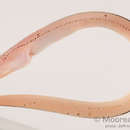en
names in breadcrumbs


Ophichthidae is a family of fish in the order Anguilliformes, commonly known as the snake eels. The term "Ophichthidae" comes from Greek ophis ("serpent") and ichthys ("fish"). Snake eels are also burrowing eels. They are named for their physical appearance, as they have long, cylindrical, snake-like bodies.[2] This family is found worldwide in tropical to warm temperate waters. They inhabit a wide range of habitats, from coastal shallows and even rivers, to depths below 800 m (2,600 ft).[3] Most species are bottom dwellers, hiding in mud or sand to capture their prey of crustaceans and small fish, but some are pelagic.[4]
These species range in total length from 5 cm (2.0 in) to 2.3 m (7.5 ft) or more. Many species lack fins altogether, improving their ability to burrow into the substrate like worms. They are often spotted or striped in colour, mimicking the appearance of venomous sea snakes to deter predators.[4] Often, they are washed ashore by large storms.
Currently, 62 recognized genera are placed in this family:
Ophichthidae is a family of fish in the order Anguilliformes, commonly known as the snake eels. The term "Ophichthidae" comes from Greek ophis ("serpent") and ichthys ("fish"). Snake eels are also burrowing eels. They are named for their physical appearance, as they have long, cylindrical, snake-like bodies. This family is found worldwide in tropical to warm temperate waters. They inhabit a wide range of habitats, from coastal shallows and even rivers, to depths below 800 m (2,600 ft). Most species are bottom dwellers, hiding in mud or sand to capture their prey of crustaceans and small fish, but some are pelagic.
These species range in total length from 5 cm (2.0 in) to 2.3 m (7.5 ft) or more. Many species lack fins altogether, improving their ability to burrow into the substrate like worms. They are often spotted or striped in colour, mimicking the appearance of venomous sea snakes to deter predators. Often, they are washed ashore by large storms.